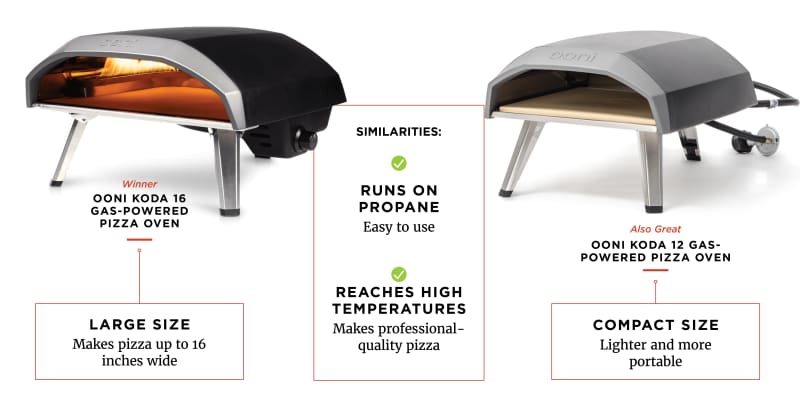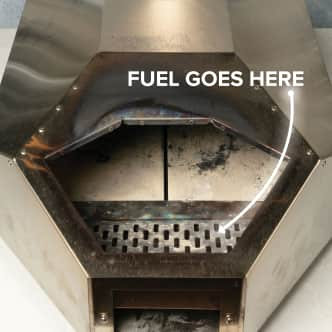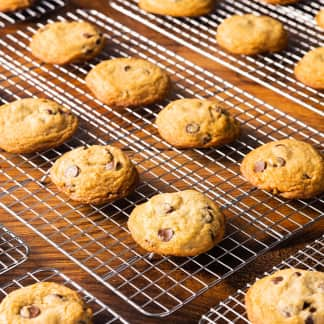The best outdoor pizza ovens run on propane, reach at least 700 degrees Fahrenheit, and have features that help distribute/radiate heat more evenly than others. Our favorite is the Ooni Koda 16 Gas-Powered Pizza Oven. It makes beautiful pizzas and is easier to use than many other models. If you’d like a smaller, lighter-weight version, we also think its little sibling, the Ooni Koda 12 Gas-Powered Pizza Oven, is great.

You can make great pizza in a home oven. But because the temperatures of most ovens top out at 500 degrees, you can’t get truly professional-quality results. For that, you need a temperature of 700 degrees or more. One option is installing a dedicated pizza oven in your kitchen or backyard, but those can be big, expensive, and more permanent than many people want. Enter portable pizza ovens, of which there are two types.
Indoor pizza ovens are midsize electric appliances that sit on the kitchen counter and generally resemble a toaster oven or oversized waffle iron but can be about twice that size. In previous tests, we learned that good performance will cost you: The best models we found, the Breville Smart Oven Pizzaiolo and the Ooni Volt 12 Electric Pizza Oven, run about $1,000. All the other models we tested performed no better than a home oven (and often much worse).

Outdoor pizza ovens, which we evaluate in this review, can be great. The best perform just as well as our favorite indoor pizza ovens and are a bit less expensive to boot. They’re intended to be portable. You can set them up in the backyard or bring them to a tailgate or campground, but all of them should be moved inside when not in use, as snow or rain can damage them. However, most weigh about the same as our favorite indoor models—between 20 and 50 pounds——though some are as heavy as 80 pounds. Outdoor pizza ovens are a bit more bulky than indoor models, with some easier to move around than others. Most are easy to assemble, and instead of being powered by electricity as indoor models are, they’re fueled by propane gas and/or wood, charcoal, or wood pellets.
Cooking pizza outdoors presents its own set of challenges—there’s a learning curve to using every model we tested, and you’ll need to tinker a little with your recipes and timing to get the best results. But these outdoor ovens are an excellent option for anyone who loves pizza and plans to make it regularly.
What to Look For
- High Temperatures: A good pizza oven should reach 700-plus degrees. In that scorching hot environment, pizzas cook in just a few minutes. Their crusts are chewy yet tender with great browning on the underside and pleasant char around the edges.

- Models Fueled with Propane Gas: These were the easiest to use. All we had to do was connect the regulators and hoses attached to the ovens to standard 20-pound propane tanks, just as we do with gas grills. A few models required smaller 14- to 16-ounce propane tanks or the purchase of an additional converter to connect to 20-pound tanks. To ignite each oven, we simply pressed in a dial, twisted it to high, held it for a few seconds, and released it when we saw a flame. Once the ovens were hot, which took 20 to 30 minutes depending on the model, we could adjust the heat by turning the dial.
- Rear Gas Burners: For an oven to work well, its burner has to heat the baking stone plus the air inside the oven, and its walls and roof have to direct the heat back onto the pizzas as they bake. In the ovens we tested, the gas burners were located either beneath the stone or at the rear of the oven. We preferred models with burners at the rear. The flames generated by these models arced up and over the baking stones, and these exposed flames made for hotter—and better—ovens. The stones reached between about 695 and 770 degrees, nearly 200 degrees hotter than the coolest oven in the lineup. In addition, the intense flames cooked the surfaces of the pizzas at the same rate as the stone cooked the bottoms, translating into tender crusts and evenly melted cheese.


What to Avoid
- Gas Burners Under the Baking Stone: Propane-fueled models with gas burners under their baking stones just didn’t perform as well. After preheating these ovens on high for 20 minutes, the maximum amount of time recommended by their manufacturers, the average temperatures of their baking stones were about 580 and 625 degrees. Though hotter than a stone heated in a home oven, both were cooler than the 700-plus degrees we wanted. (Because most companies caution that heating the empty ovens for too long can damage them, we didn’t extend the recommended 20-minute preheating time.) Using these ovens to bake pizza was akin to cooking the pizzas in a skillet on a stovetop burner; the pizzas baked from the bottom up and the crusts absorbed a lot of heat in the time it took the toppings to cook through. All the pizza crusts—whether they were meant to be chewy thin crust or light, airy Neapolitan-style—dried out a little and were even a bit crunchy. They tasted good, but they weren’t true to the intended style.

We recorded the temperature inside the ovens to see which ones got as hot as they promised.
Other Considerations
- Multifuel Ovens: Some pizza ovens come with the option to cook either with propane or with wood, charcoal, and/or wood pellets. (A few use wood, charcoal, or pellets as their primary fuel source and offer the option to add on a propane attachment.) While we like and recommend several of these models, we’ve found that they work best when used with propane. The fuel chambers that house the wood, charcoal, or pellets are usually quite small. Wood in particular posed a number of challenges. You must cut logs down significantly to get them to fit inside the chamber, and while we were eventually able to get some ovens to reach 700 degrees, we had to feed the fire pretty much continuously to maintain it. (At one point while using wood, a robust flame died in the time it took one of our testers to stretch and top a pizza, which couldn’t have been more than 90 seconds.) To use wood in your oven, you really need two people: one to maintain the fire and one to prepare and monitor the pizzas. And even in large professional wood-fired ovens, pizzas cook too quickly for them to pick up any wood flavor. Charcoal was easier to pile into the chamber, and we didn’t need to keep adding it to maintain a consistent temperature for longer periods. But as with the wood, we had a hard time getting that temperature high enough to make truly outstanding pizza. Overall, multifuel models require you to pay more for fairly limited gains in functionality. Charcoal can be great for low-and-slow cooking such as roasting meat, and you could use wood for shorter cooking stints, such as roasting vegetables, but those are secondary uses for a pizza oven.


- Size: Outdoor pizza ovens come in a variety of sizes, and the choice of which to get depends on the size of the space you’d put your oven in. Larger models are more versatile, as they can fit large and small pizzas, but they’re also bigger and heavier, making them harder to move around. More compact models are best for smaller spaces and are easier to move; they just make smaller pies.
The Tests:
- Make Thin-Crust Pizza using propane as a fuel source
- Make Neapolitan-style pizza using propane as a fuel source
- With multifuel models, make Neapolitan-style pizza using wood and, if the ovens can accommodate it, charcoal
- Monitor the temperature of the baking stone, internal air temperature just above the cooking surface, and the ceiling of the oven throughout all tests
How We Rated:
- Performance: We evaluated the quality of the pizzas we made with each oven.
- Ease of Use: We considered how easy it was to set up the ovens, connect them to propane tanks, and ignite them. We also rated the models on how easy they were to use with other fuels (wood, charcoal) where applicable. We evaluated how easy it was to produce evenly cooked pizzas, including whether there was enough room to launch, rotate, and remove them.

























